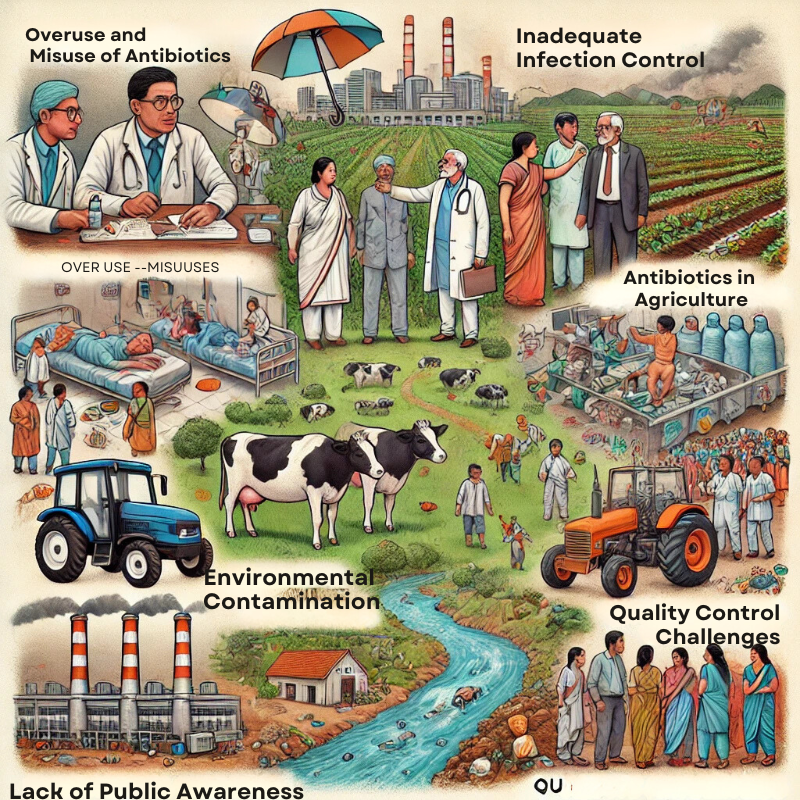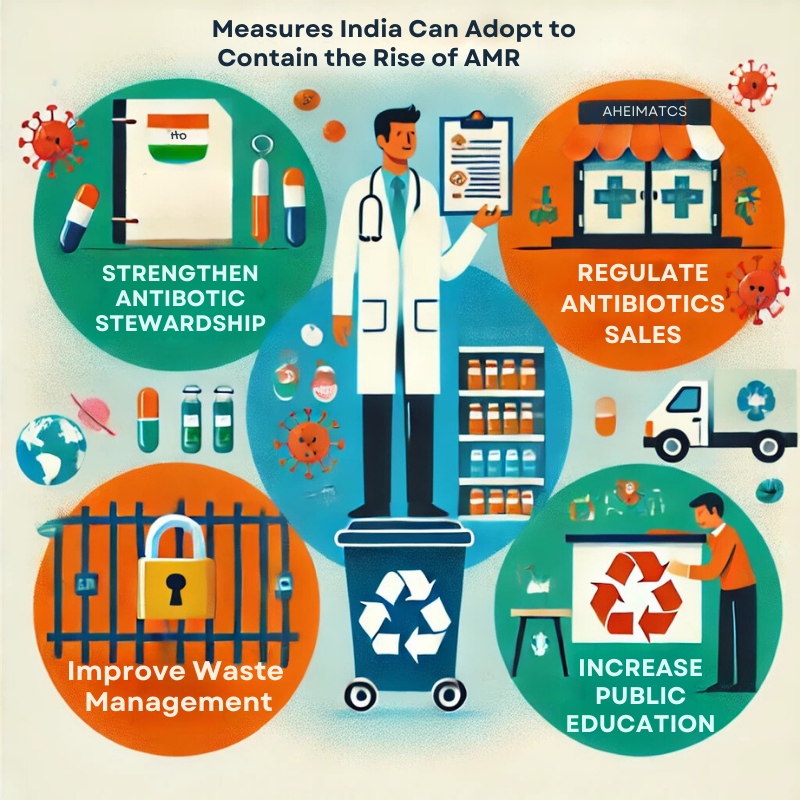Antimicrobial resistance is an increasingly emerging issue worldwide, and India is no exception. The editorial features bacteriophages, or “phages,” as a promising solution to this pressing problem. Phages are viruses that selectively attack and kill bacteria and hence could be a potential alternative to conventional antibiotics to treat such infections as they become effective again. With the projection that soon AMR is going to claim millions of lives, the exploration of phage therapy gains importance, mainly for India. This may be the turn in the story of drug-resistant bacteria, which will give sustainable and effective treatments.
Bacteriophages, or simply phages, have emerged as one of the emerging solutions to the deeply growing problem of antimicrobial resistance (AMR). For viruses that target bacteria, there is a specific mechanism to treat antibiotic-resistant strains. With traditional antibiotics declining, the therapeutic application of phages becomes ever so imperative in countries such as India, struggling to cope up with severe drug resistance problems. Phage therapy may serve as a shining light in the dark fight against superbugs.
| GS Paper | GS Paper III |
| Topics for UPSC Prelims | Bacteriophages, Antimicrobial Resistance, Antibiotics, Central Drug Regulator, E. coli and Klebsiella pneumoniae, 2019 Colistin ban, AMR Surveillance Network, One Health approach, Schedule H1 of the Drugs and Cosmetics Rules, Ayushman Arogya Mandir, Global Antimicrobial Resistance Surveillance System. |
| Topics for UPSC Mains | Factors Driving the Growth of AMR in India, Indian Government Initiatives to Tackle AMR. |
Origin of the Article
This editorial is based on “Virtuous viruses to fight antimicrobial resistance” published in Hindustan Times on 07/10/2024. It discusses the potential role of bacteriophages in addressing antimicrobial resistance, particularly in countries like India facing severe drug resistance challenges.
Relevance for UPSC Aspirants
The UPSC aspirant must understand AMR and possible solutions such as phage therapy. This topic falls under General Studies Papers II and III, which deal with health, government policies, and technology. The knowledge about AMR, therefore, enables the understanding of global health threats and strategies of public health in India and allows the aspirant to answer questions related to the topic in a précised manner in an examination.
Why in News?
The topic of antimicrobial resistance or AMR is of high importance to UPSC aspirants, as the topic directly deals with the relation with public health, economic stability, and global cooperation. The issue has been in the news lately for considerable media attention because of the current threat that has forced countries like India to create alternative therapies like phage therapy. A multidimensional understanding of the challenges and solutions concerning AMR links this branch to UPSC questions regarding health policies and antibiotic overuse in the past.
What is Antimicrobial Resistance?
Antimicrobial resistance (AMR) means that the micro-organisms (bacteria, viruses, fungi, and parasites) are resistant to drugs that used to be effective for treatment against infections. Once there is resistance, then it makes conventional treatments ineffective, allowing infections that should be short-lived to linger and flourish, increasing the chances of severe illness and death. WHO reports that AMR directly accounted for 1.27 million deaths in 2019. The World Bank warns that by 2030, AMR may cause healthcare-related losses and GDP of up to US $3.4 trillion annually.

Factors Driving the Growth of AMR in India
The growth of AMR in India is driven by technological improvements, increasing demand for accurate billing and enhanced energy management, government initiatives toward the vision of smart grids, and efficient utility operations toward improving general service delivery.
Overuse and Misuse of Antibiotics
Antibiotics are widely available from pharmacies and other convenient points in India, wherein their prescribed frequency is overstretched and taken excessively. A Lancet study conducted in 2019 showed that over 47% of antibiotic preparations in India’s private sectors were not approved at that time. Excessive availability and prescription will further encourage resistance among bacteria, thereby defeating the very treatment that is being proposed, which in turn creates an AMR crisis.
Inadequate Infection Control and Hygiene Practices in Healthcare Settings
Poor infection control in Indian hospitals forms a significant addition to AMR. Very high incidences of hospital-acquired infections, especially resistant bacteria prevail. Many hospitals do not have the infrastructure for stringent control measures, and the rates of multi-drug resistant infections have gone up with time, most of which relate to ICU cases of E. coli and Klebsiella pneumonia.
Use of Antibiotics in Agriculture and Animal Husbandry
Animal growth enhancement and prevention against diseases involve high levels of antibiotic usage in the agricultural sector of India, contributing further to AMR in the form of residues of antibiotics entering the human food chain, thus aggravating the problem. Unregulated usage continues to pose a threat to public health despite government guidelines not being followed, as it lack enforcement.
Environmental Contamination by Pharmaceutical Waste
Such AMR, involving high antibiotic usage levels in the agricultural sector of India, is involved in enhancing growth and prevention against diseases in animals. All these residues of antibiotics enter the human food chain to further exacerbate the problem. Even though government guidelines are not followed by the agricultural sector, unregulated usage continues to pose a threat to public health.
Challenges in Pharmaceutical Quality Control
The rapid expansion of India’s pharmaceutical sector often surpasses regulatory oversight, leading to substandard antibiotic production. Poor-quality drugs, lacking effective active ingredients, contribute to AMR. Despite government deadlines for compliance with WHO standards, uneven adherence persists, underscoring the need for enhanced regulatory vigilance.
Lack of Public Awareness
Public awareness of AMR is very poor, even in rural areas, where there is much inappropriate usage of antibiotics. “Within the country, a survey conducted showed that 24% of the people were unaware of the consequences brought about by AMR.” Despite efforts to educate a few states, ignorance continues to fuel AMR across states, thus requiring such campaigns.
Indian Government Initiatives to Tackle AMR
The Government of India has undertaken several activities against AMR, and some of them include the AMR Surveillance Network that spans 36 sites in India. The National Action Plan on AMR, launched in 2017, follows the One Health approach. There are also collaborative efforts with countries like Norway and Germany on improving AMR research while at the same time, spreading campaigns on the responsible usage of antibiotics and good hygiene practices.

Measures India Can Adopt to Contain the Rise of AMR
To control the growth of the Automated Meter Reading (AMR) market in India, efforts include strong data privacy policies, firming up cybersecurity measures, increasing public awareness, investment in upgrading existing infrastructure, and collaboration among all stakeholders to ensure the effective implementation and management of AMR systems.
Strengthen Antibiotic Stewardship Programs in Healthcare Settings
Enforced antibiotic stewardship programs through prescription auditing supported by electronic health technological support that offers real-time advice for the use of antibiotics. The other measure is to promote rapid diagnostic tests, which would predominantly contribute towards restraints on the misuse of antibiotics through riddance of the unnecessary prescriptions usually made.
Enforce Regulations on Over-the-counter Antibiotic Sales
India should have rigorous controls to include Schedule H1, among other controls, for the prescriptionless sale of antibiotics. A computerized system to monitor the dispensing pattern of antibiotics in the country will be useful in designing an appropriate implementation plan. Publicity campaigns must be strengthened to create an awareness of the dangers of self-medication and responsible usage of antibiotics.
Regulate Antibiotic Use in Agriculture and Animal Husbandry
Establishing surveillance systems, and promotion of alternative uses such as probiotics reduces the use of antibiotics in agriculture, thereby reducing the contribution of agriculture to AMR. Implementation of measures by the National Action Plan to phase out antibiotics as growth promoters in agriculture is critical.
Improve Wastewater Treatment in Pharmaceutical Manufacturing
Pharmaceutical waste streams must be strengthened in terms of regulations on their treatment. “Green pharmacy” certification for compliant manufacturers and investment in advanced treatment technologies would prevent hazardous environmental pollutants from ever forming, impeding the development of AMR.
Enhance Infection Prevention and Control Measures
Improving infection control in health care is a must. Regular audits associated with the accreditation of the hospitals, investment in infrastructures, and nationwide hygiene campaigns help improve sanitation by reducing infection rates and AMR spread in healthcare settings.
Expand and Strengthen AMR Surveillance
AMR surveillance needs to be expanded. It would be integrated into pre-existing health programs and even grafted onto the One Health approach, thus improving monitoring efforts. Advanced genomic techniques and international collaborations would, for sure, have better collections of data to aid the global fight against AMR.
PESTEL Analysis
| Political: The Indian government has launched initiatives like the AMR Surveillance Network and the National Action Plan on AMR, showcasing a strong political commitment to combating AMR. This is complemented by international collaborations to develop new treatments and a regulatory framework that includes enforcing regulations on antibiotic sales and banning certain drugs. Economic: The economic implications of AMR are significant, increasing healthcare costs due to prolonged hospital stays and more intensive care. The pharmaceutical industry faces both challenges and opportunities, as there is a pressing need for new antibiotics and alternative therapies like bacteriophages, potentially driving research, development, and economic growth. Funding for research in AMR and bacteriophage therapy is also a critical economic factor, necessitating both government and private sector investment. Social: A major social challenge is the public’s lack of awareness about AMR and proper antibiotic usage, which necessitates robust educational campaigns. The impact of AMR on public health is profound, increasing the risk of severe health complications and mortality. Cultural practices in some regions that encourage over-prescription and a preference for quick medical fixes also need to be addressed through social reforms. Technological: Technological advancements are pivotal in the fight against AMR. This includes the development and application of bacteriophages to combat drug-resistant bacteria, improved technologies for monitoring drug resistance, and innovations in waste management to ensure proper treatment of pharmaceutical wastes to prevent environmental contamination. Environmental: Environmental factors include contamination from pharmaceutical waste, which contributes to the development of resistant bacteria. Additionally, the use of antibiotics in agriculture leads to environmental contamination, underscoring the need for effective management strategies to prevent the spread of AMR. Legal: The legal landscape involves stringent regulations on antibiotic use and prescription, requiring enforcement to reduce misuse. Legal standards for pharmaceutical waste management are also crucial to prevent environmental contamination. Furthermore, enhancing quality control in antibiotic production is necessary to ensure that they are safe and effective. |
Conclusion
This requires a multi-dimensional approach and will include adopting bacteriophage therapy as a possible alternative to antibiotics. Other integral steps would be the strengthening of rules and regulations, public awareness, and better infection control. The only effective way for India to ward off this growing public health menace would be through cross-sector collaboration along with appropriate research priority.
| UPSC Civil Services Examination, Previous Year Questions (PYQs) Mains Q. In what way could replacement of price subsidy with Direct Benefit Transfer (DBT) change the scenario of subsidies in India? Discuss.(UPSC Mains 2015, GS Paper III) Q. Discuss the role of bacteriophages in combating antimicrobial resistance (AMR). How can phage therapy be integrated into India’s healthcare system to address the challenge of drug-resistant infections? |



